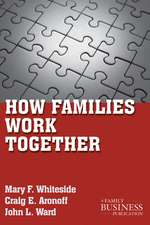Governing the Firm: Workers' Control in Theory and Practice
Autor Gregory K. Dowen Limba Engleză Paperback – 16 feb 2003
| Toate formatele și edițiile | Preț | Express |
|---|---|---|
| Paperback (1) | 350.97 lei 6-8 săpt. | |
| Cambridge University Press – 16 feb 2003 | 350.97 lei 6-8 săpt. | |
| Hardback (1) | 699.45 lei 6-8 săpt. | |
| Cambridge University Press – 16 feb 2003 | 699.45 lei 6-8 săpt. |
Preț: 350.97 lei
Nou
Puncte Express: 526
Preț estimativ în valută:
67.16€ • 70.31$ • 55.57£
67.16€ • 70.31$ • 55.57£
Carte tipărită la comandă
Livrare economică 05-19 aprilie
Preluare comenzi: 021 569.72.76
Specificații
ISBN-13: 9780521522212
ISBN-10: 0521522218
Pagini: 342
Ilustrații: 1 b/w illus. 6 tables
Dimensiuni: 153 x 228 x 20 mm
Greutate: 0.46 kg
Editura: Cambridge University Press
Colecția Cambridge University Press
Locul publicării:New York, United States
ISBN-10: 0521522218
Pagini: 342
Ilustrații: 1 b/w illus. 6 tables
Dimensiuni: 153 x 228 x 20 mm
Greutate: 0.46 kg
Editura: Cambridge University Press
Colecția Cambridge University Press
Locul publicării:New York, United States
Cuprins
1. Introduction: 1.1 Economic systems; 1.2 The control dimension; 1.3 Looking for clues; 1.4 A projected synthesis; 1.5 The plan of the book; 2. Normative perspectives: 2.1 Why care about workers' control?; 2.2 Equality; 2.3 Democracy; 2.4 Property; 2.5 Dignity; 2.6 Community; 2.7 The author shows his cards; 3. Workers' control in action (I): 3.1 Surveying the terrain; 3.2 The Plywood cooperatives; 3.3 The Mondragon cooperatives; 4. Workers' control in action (II): 4.1 The Lega cooperatives; 4.2 Employee stock ownership plans; 4.3 Codetermination; 5. Conceptual foundations: 5.1 The theory of the firm; 5.2 The nature of authority; 5.3 The locus of control; 5.4 Why firms cannot be owned; 5.5 Asset ownership; 5.6 Residual claims; 6. Explanatory strategies: 6.1 The symmetry principle; 6.2 The replication principle; 6.3 Transaction costs; 6.4 Optimal contracting; 6.5 Adverse selection; 6.6 Repeated games; 6.7 Path dependence; 6.8 Cultural explanations; 6.9 The strategy to be pursued; 7. A question of objectives: 7.1 What do labor-managed firms maximize?; 7.2 The Illyrian firm; 7.3 Membership markets and labor markets; 7.4 Membership markets and stock markets; 7.5 Imperfect membership markets; 7.6 What does the evidence say?; 7.7 Some lessons; 8. Views from economic theory I: 8.1 Explaining the rarity of workers' control; 8.2 Asset ownership: incentives and information; 8.3 Asset ownership: bargaining and information; 8.4 Can asset specificity explain the rarity of workers' control?; 8.5 Work incentives without risk aversion; 8.6 Work incentives with risk aversion; 8.7 Can work incentives explain the rarity of workers' control?; 9. Views from economic theory (II): 9.1 Capital constraints; 9.2 Debt financing; 9.3 Equity financing; 9.4 Can capital constraints explain the rarity of workers' control?; 9.5 Portfolio diversification; 9.6 Can portfolio diversification explain the rarity of workers' control?; 9.7 Collective choice; 9.8 Can collective choice explain the rarity of workers' control?; 10. Transitions and clusters: 10.1 Organizational demography; 10.2 Formation rates; 10.3 Worker takeovers; 10.4 Degeneration; 10.5 Investor takeovers; 10.6 Survival rates; 10.7 Business cycles; 10.8 Clusters; 11. Toward a synthesis: 11.1 The causal tapestry; 11.2 Credible commitment toward labor; 11.3 Credible commitment toward capital; 11.4 The composition of control groups; 11.5 The commodification of control rights; 11.6 Intellectual history and current debates; 11.7 Is workers' control a unitary phenomenon?; 12. Getting there from here: 12.1 Practical considerations; 12.2 A modest proposal; 12.3 Reassuring shareholders; 12.4 Governing firms; 12.5 Trading jobs; 12.6 Sample calculations; 12.7 The long and winding road.
Recenzii
'It's been a long time since the appearance of so important a book on worker participation and the governance of enterprises. Dow lays out the states of our knowledge and of our ignorance clearly and readably, inviting us to join him in thinking about what might be the next steps forward. No better introduction to the subject matter is available.' Louis Putterman, Brown University
'In market economies, most firms are owned and managed by those who supply financial capital, not by the people who work in them. Why? This is a topic that sometimes generates more heat than light. However, in this dispassionate analysis, Greg Dow perceptively examines the rich and diverse literature on this topic and comes up with important insights. This book will immediately become the standard reference on worker ownership and management and is thoroughly recommended for both specialist and non-specialist alike.' John Pencavel, Stanford University
'What difference does it make when workers rather than capital owners control firms, electing managers, and owning (for better or worse) the fruits of their labor? Greg Dow's Governing the Firm provides the economic analysis and empirical facts based on the experience production cooperatives around the world to answer this question. It's the best book on the subject.' Samuel Bowles, University of Massachusetts, Amherst
'In market economies, most firms are owned and managed by those who supply financial capital, not by the people who work in them. Why? This is a topic that sometimes generates more heat than light. However, in this dispassionate analysis, Greg Dow perceptively examines the rich and diverse literature on this topic and comes up with important insights. This book will immediately become the standard reference on worker ownership and management and is thoroughly recommended for both specialist and non-specialist alike.' John Pencavel, Stanford University
'What difference does it make when workers rather than capital owners control firms, electing managers, and owning (for better or worse) the fruits of their labor? Greg Dow's Governing the Firm provides the economic analysis and empirical facts based on the experience production cooperatives around the world to answer this question. It's the best book on the subject.' Samuel Bowles, University of Massachusetts, Amherst
Descriere
This book provides case studies of worker-controlled firms and surveys available evidence on their behavior.












